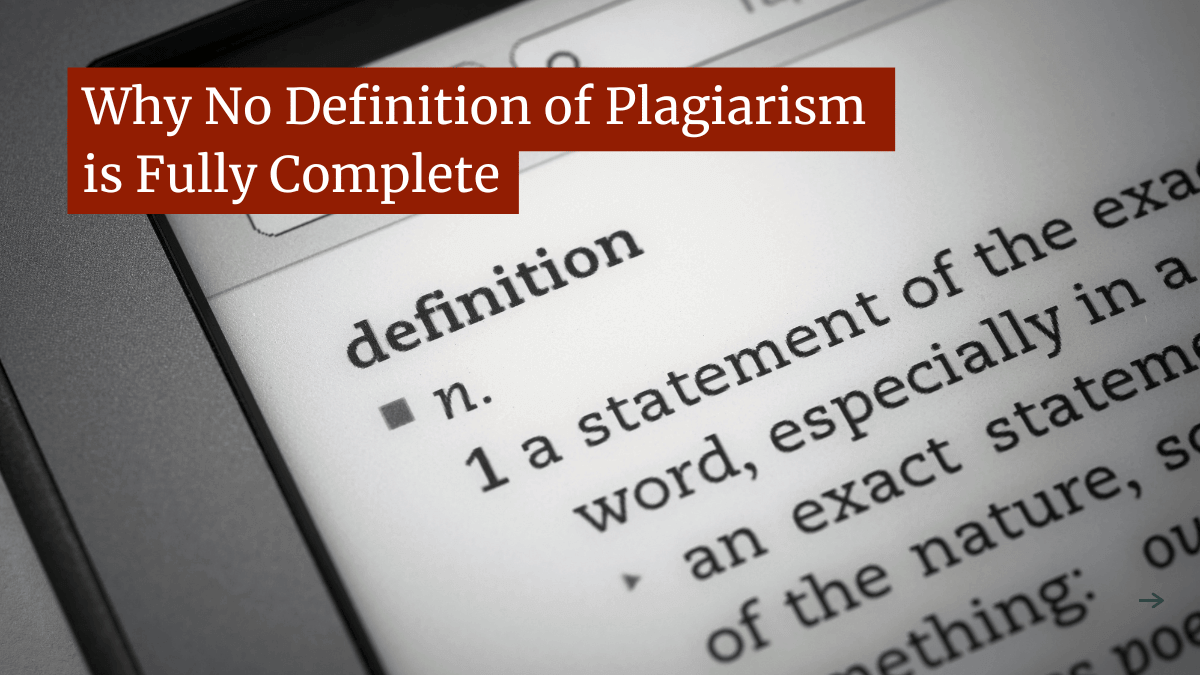The Definition of Plagiarism

As we discussed in June 2021, plagiarism is an extremely difficult subject to nail down and find agreement on.
While there are things most people will agree are or are not plagiarism, the space is filled with gray areas where reasonable people can disagree.
This makes carving out a specific definition of plagiarism difficult. However, it is still extremely important to have one. A good working definition of plagiarism is one of the first and most important steps in enforcing the rules around it.
However, if you look up ten definitions of plagiarism, you’re likely going to find ten slightly different approaches to it. That said, there are some things that remain consistent and give us a path to creating a single definition of plagiarism that should cover the most important points.
To get there, though, we must start by looking at some of the definitions that are currently being used today.
Some Current Definitions
The first place to start is with a dictionary. There, Mariam Webster has a simple definition of “plagiarize” as a transitive verb.
to steal and pass off (the ideas or words of another) as one’s own : use (another’s production) without crediting the source
Dictionary.com’s definition is a good bit longer and takes a more subtle approach.
an act or instance of using or closely imitating the language and thoughts of another author without authorization and the representation of that author’s work as one’s own, as by not crediting the original author:
While these are useful definitions. They are also not the ones that are most likely to be used to enforce ethical standards. To that end, we can turn to university honor codes and their definitions of plagiarism.
For example, Stanford defines plagiarism as:
For purposes of the Stanford University Honor Code, plagiarism is defined as the use, without giving reasonable and appropriate credit to or acknowledging the author or source, of another person’s original work, whether such work is made up of code, formulas, ideas, language, research, strategies, writing or other form(s). Moreover, verbatim text from another source must always be put in (or within) quotation marks.
Virginia Tech defines plagiarism as:
Plagiarism includes the copying of the language, structure, programming, computer code, ideas, and/or thoughts of another and passing off the same as one’s own original work, or attempts thereof.
Other schools, such as Brigham Young University and Wesleyan University, use longer definitions that cover a wide range of situations that are common to schools.
But while all these definitions are different, they all contain some common elements. Those, in turn, are the elements that truly define what is and is not plagiarism.
The Common Elements
When you look at the various definitions of plagiarism, two elements are almost always shared between them.
- Use of Another’s Work: Plagiarism always involves the use of another’s work. This work can be almost anything, including text, images, audio, video, computer code or other artwork. However, one area plagiarism differs from copyright is that it also covers the ideas, data and facts that are not part of the “expression” io the work.
- Without Proper Attribution: Work that is properly attributed is never considered plagiarized. However, it is important that the attribution be the correct level for both what is used and where it is used. For example, direct quotes require either quotation marks or blockquotes. Also, an academic paper will be cited differently than a news article.
While those two elements are common sense, they are also very broad. For the purpose of plagiarism, a work can be almost anything, including intangible ideas. Likewise, attribution can mean anything from forgetting quotation marks in a short passage to outright passing off someone else’s completed work as your own.
Because of this, any working definition of plagiarism has to be extremely broad. It also covers a wide range of activities. For example, in academia, it covers everything from the use of an essay mill to fully cheat on an assignment all the way to an accidentally omitted citation in a paper.
But while this means that a wide variety of activities are considered plagiarism, it does not mean that all plagiarisms are equal. For example, looking back to the Wesleyan definition, they specifically separate out intentional and inadvertent plagiarism, making it clear that both are plagiarism and both can be punished, but that the former is more severe than the latter.
In short, plagiarism is an umbrella term that covers a wide variety of attribution issues, not just one specific action.
My Personal, Working Definition
Because of the broad nature of the plagiarism, most definitions are well-served by being simple and broad.
As such, the definition I’ve used for much of my career is as simple as it is short.
Plagiarism is the use of another person’s work or ideas without proper attribution or citation.
Note that there is no mention of intent, no discussion on what kinds of work (as it can be any kind of work) or any details on what is proper attribution in a particular case.
However, because of that, it’s a definition that is largely useless for determining how to handle any particular case or whether an incident was an ethical infraction.
That, instead, has to be taken on a case-by-case basis, which is precisely how accusations of plagiarism should be handled.
Bottom Line
In the end, plagiarism is an extremely complicated topic and any definition that is both complete and brief will, by necessity, be extremely broad and largely useless for dealing with specific cases.
Like many other words, the word plagiarism is largely meaningless without modifiers or details. As such, it’s a subject that requires nuanced discussion, not simple definitions.
But, nonetheless, definitions are often important as they are a starting point for that discussion. That, in turn, is precisely what any good definition of plagiarism should do: Get the discussion started.
Still, instead of trying to find the perfect definition of plagiarism, the focus should be on improving the ways we talk and think about the topic.
Definitions are great, but when careers are on the line, it’s important to approach the topic with the nuance and reverence that the subject commands.
Want to Reuse or Republish this Content?
If you want to feature this article in your site, classroom or elsewhere, just let us know! We usually grant permission within 24 hours.
